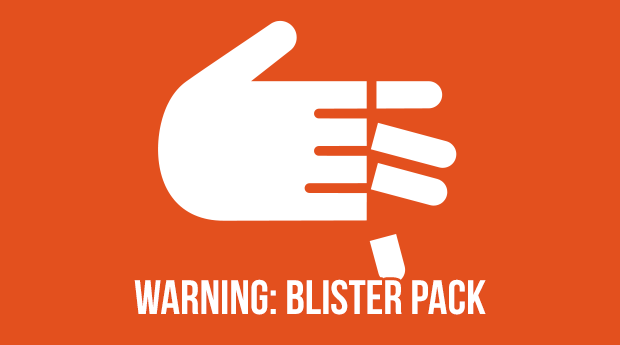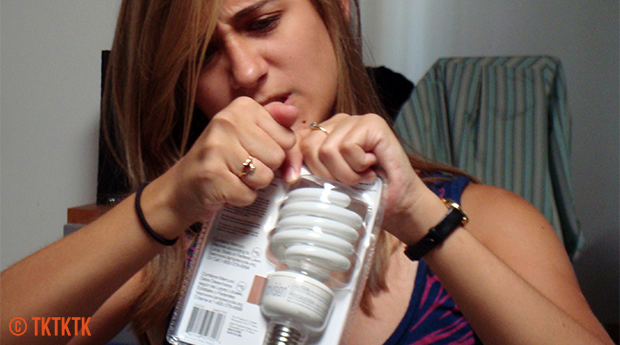UX IRL: The Dangers of Clamshell Packaging

For many of us at Nebo, it can be hard to leave our work at work. Intuitively, we apply the same human-centered approach we use for our clients to our everyday experiences. Realizing that it is futile to fight it, we’ve decided to embrace it. We’ve decided to look at everyday things and figure out ways that the user experience can be improved. This is a look at the user experience in real life, or as people online might put it, UX IRL.
Today’s subject: clamshell packaging.
Ripping the Problem Wide Open
When you’re a kid, the entire physical world seems unattainable to you. It’s filled with things your undeveloped fingers can’t open without help from an adult – soda cans, Capri Suns, glass jars. And this cruel fact of life always made itself most apparent on days that should have been the best of our young lives. Birthdays. Christmas. Any time your parents needed to buy you off after accidentally wronging you.
We’d excitedly unwrap an action figure or a Nerf gun refill pack only to find the goods encased in a rigid plastic tomb – a clamshell: a particularly nasty type of blister pack. And this thing that we’d be dying to run off and start a fantastic adventure with, this thing that was supposed to be all ours, would first need to be surgically removed from its casing by our parents before we could have our way with it. And we all know that delaying gratification wasn’t exactly our strong suit back then.
But what makes the clamshell experience so much more traumatic than, say, trying to break into a jar of Smuckers Jelly, is that clamshells don’t get any easier to open when you grow up. And then, there are no adults to turn to. You ARE the adult. That means you’re on your own every time you buy a thumb drive or a screwdriver or a disposable razor -- left to bend, twist, tear, and even bite at the plastic in hopes of finding a weak spot. These packages are so famously difficult to open that they’ve spawned an entire industry of gadgets, like the Pyranna and the OpenIt, to help poor consumers like us.
But most of us either don’t know about these magical gizmos or don’t feel compelled to go out and spend our hard earned money on one, so we’re left with whatever sharp objects we have lying around the house. Scissors. Knives. Box cutters. Pens. Keys. Toothpicks. You name it.

Of course, since there is no preferred point of entry on a clamshell, we have no choice but to blindly jab our blade indiscriminately into the slippery plastic packing, and I think we all know how that can end up. In 2004, nearly 6500 Americans were admitted to emergency rooms with injuries sustained while trying to open various types of blister packs, according to Wired Magazine. So, not only are they aggravating, they can be downright lethal.
Oh, and if that wasn’t enough, they’re also terrible for the environment.
Shellacking the Clamshell
Many kinds of blister packs, most prominently the clamshell, obviously have a huge UX problem -- how can we fix it?
Use Less Plastic
It’s not necessarily news that clamshell packaging is the pits. In fact, plenty of big time retailers have been working over the past couple of years to reduce the amount of plastic in their packaging. The problem is that they haven’t gone far enough.
The newest fad in clamshells is creating the skeleton of the packaging out of cardboard, which is less likely to cause injury, is better for the environment, and can easily be decorated or branded. But this new breed of container still houses the product itself in a hard plastic bubble. Even if the cardboard edges are easier to rip, all they’ve done is make a dangerous, aggravating process slightly less dangerous and aggravating. They haven’t turned opening a product into a seamless experience.
Go All In on Cardboard
When it comes to progress, huge brands like Amazon and Sony are leading the charge. In 2008, Amazon launched its line of Frustration-Free Packaging while Sony declared “Death to the Clamshell”. Both have taken the cardboard craze a step further, designing packaging made almost entirely out of the flexible, recyclable material.
The best of this new generation of product packaging features sleek, boxy designs that open via an easily accessible tab and collapse naturally for easy disposal. While anything is possible, it certainly sounds a lot more difficult to maim yourself on something so harmless.
Find New Deterrents
Lest we be accused of oversimplifying the situation, retailers and manufacturers do have legitimate reasons for their hesitance to ditch rage-inducing plastic clamshells. The advantage of bulky, rigid, impenetrable fortress-like packaging is that it makes a product significantly more difficult to shoplift.
It comes down to how much a brand values their users. There are always other ways to deter theft, though they may not be as cost effective. There’s the option of bringing on additional security personnel, revamping surveillance systems, or using other non-packing related prevention methods like adding sensors or security tethers to products. What retailers and manufacturers need to decide is whether the bottom line is worth more than easing their customers’ frustrations or even preventing injury. But, either way, we’re way past the point where brands can sweep the complaints under the rug and pretend that opening clamshells isn’t an enormous problem.
Moving Forward
The secret has been out for a while now. Clamshell packaging harms the environment and it harms our fingers, palms, and wrists; putting us at risk for unnecessary, brutal injuries. All in the name of a parcel that doesn’t fit cleanly under a shoplifter’s shirt.
But we’re making progress. Amazon and Sony have drawn their line in the sand. Even Walmart pledged to reduce the amount of plastic in its packaging by 5%, which is a start, but we’ve all obviously got a long way to go. Maybe one day we’ll live in a world where our kids won’t have to wait on us to open their action figures. Or a world where the knives in our home are for cutting food and cutting food only. If we ever do, it’ll be because retailers finally realized the importance of UX IRL.
In the meantime, that day can’t come soon enough.
Comments
Add A CommentThe post is very interesting. Thanks!
I landed up in the hospital last night from trying to open the package of a rechargeable battery for a Troybilt weed-eater. I got 98% of it open after 15 minutes of arduously cutting with scissors. Then as a result of exhausted hands and reaching a point in the plastic that was just too tough to cut, I decided to try to pull it apart the rest of the way. Bad idea! The jagged edges created by the scissors slit my index finger nearly to the bone!